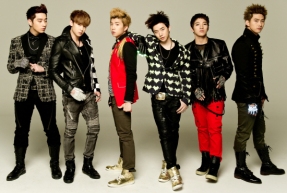The Music Industry:
Last week we ventured into the world of a South Korean idol, but we didn’t say much about the actual music industry that they’re plopped right in the middle of. Although it might not occur to a person that music industries in different countries can have quite varied standards and practices, it’s the truth. Come to think of it, this author probably knows a heck of a lot more about the Japanese and South Korean music industries than about the ones in English-speaking nations. The music industry is a whole other culture that will remain a bit of an enigma until you take the time to immerse yourself in it.
The Big Three:
In this string of letters “JYPSMYG” lie the “Big Three” South Korean record labels. SM Entertainment, JYP Entertainment, and YG Entertainment were all originally named after their founders, Soo-Man Lee, Jin-Young Park, and Hyung-Suk Yang, called Yang-goon. After a few years SM was officially changed to Star Museum, although it’s likely fans and the general public still think of it as standing for Soo-Man.
There are plenty of other companies that are host to successful idol groups, such as Cube Entertainment, Pledis Entertainment, and LOEN Entertainment, but the Big Three definitely gross the most each year and are the first to come to the mind of anyone familiar with the industry. Collectively, these entertainment companies provide South Korea with possibly the most populated idol music genre, and almost certainly the most well-trained. Unfortunately, the industry also has its dark corners, with accusations of human rights violations among the heavier issues.
Musical Style:
 South Korean music currently has been following the edgier and more cutting-edge trends. Dubstep and house music are the new favorites to incorporate into songs, and electronic modification is pretty much a given. Luckily the fascination with auto-tune that briefly appeared in the early and mid 2000’s has dwindled until only more sophisticated or purposefully stylistic uses of it remain. Pop idols aren’t known for their accoustic performances anyway, but even then, acoustic songs aren’t nearly as popular for South Korean boybands and girlbands as they are elsewhere, especially in studio albums.
South Korean music currently has been following the edgier and more cutting-edge trends. Dubstep and house music are the new favorites to incorporate into songs, and electronic modification is pretty much a given. Luckily the fascination with auto-tune that briefly appeared in the early and mid 2000’s has dwindled until only more sophisticated or purposefully stylistic uses of it remain. Pop idols aren’t known for their accoustic performances anyway, but even then, acoustic songs aren’t nearly as popular for South Korean boybands and girlbands as they are elsewhere, especially in studio albums.
Even with passing trends, there are still some constants in idol music. The Hallyu Wave is the name attributed to the phenomenal success of South Korean music and other entertainment in international markets. Some of the possible reasons for this success is the prevalence of social media use among South Korean celebrities and the way the industry embraces the internet and involves fans from around the world in votes and other events. Groups have also taken advantage of foreign markets by using targeted subgroups that learn to speak and perform in another language, such as EXO-M (M for Mandarin Chinese). Every group seems to have at least one member that is bilingual, if not trilingual.
Another big reason for the Hallyu Wave is probably the composition of South Korean pop music. Idol music is most often either a catchy dance beat or a smooth, sweet love song, both of which have wide appeal. Most groups have a rapper, and incidentally or not, most singles have a rap break-down somewhere within the song. This adds variety, and since rap focuses on beat, which is one of the most addictive aspects of a song, that probably helps as well. The final clincher is that South Korean idol songs can be quite repetitive (check out “Sorry Sorry” by Super Junior) and also generally have at least one refrain in English. This not only makes it easier to get the songs stuck in your head, but also allows anyone who knows English to sing along to at least part of the song.
Releases:
As you get to know South Korean boybands and girlbands, you come to realize that they have a very distinctive way of releasing music. Aside from songs that are recorded as original songs for drama soundtracks, idol bands pretty much never release singles that aren’t promoting an album or EP (extended play). Even for soundtracks, most often only a single member will be doing the song for the drama, so it won’t be released as a single for the group. In effect, unattached singles do not exist. Another note to this is that albums and extended plays tend to be released in almost equal measure, and garner about the same amount of fanfare in terms of promotion.
 Every time a group releases an EP or album in South Korea, it’s a “comeback”. This is confusing at first, because in the U.S., a comeback isn’t really a comeback unless it’s been quite a while since the artist has released anything, usually a few years of complete inactivity. Inactivity almost never factors in for South Korean idol groups because even when they aren’t releasing music, they’re going on variety shows or acting in dramas or dj-ing radio shows, so they aren’t really out of the public eye. They haven’t gone anywhere.
Every time a group releases an EP or album in South Korea, it’s a “comeback”. This is confusing at first, because in the U.S., a comeback isn’t really a comeback unless it’s been quite a while since the artist has released anything, usually a few years of complete inactivity. Inactivity almost never factors in for South Korean idol groups because even when they aren’t releasing music, they’re going on variety shows or acting in dramas or dj-ing radio shows, so they aren’t really out of the public eye. They haven’t gone anywhere.
Still, no matter whether it’s been a month or two years, a South Korean idol release is always a “comeback”. The only possible exception is the single release for a repackaged album. It may be a somewhat newer trend, but it seems like there’s a very specific formula for releases. When an album is first released, it has a set of tracks and one of them is chosen as a single. A month or so later, a repackaged album is released under a different title and with a different single. The repackaged album contains the same songs as the first, but with around 3-5 additional songs. This is essentially the South Korean tactic for getting fans to buy multiple versions of the same product. Releases also come with special materials such as stickers of a specific member, so this is another way consumers can be persuaded to spend more until they either find their favorite or collect them all.
Music Videos:
For each single, a music video, always referred to as an “MV” is released. South Korea has very strict laws relating to the content of publicly available releases. These regulations are meant to protect young people from bad language, the degrading of cultural values, and promiscuous images. Every so often an MV will be determined unacceptable, and because pop idols are meant for the mainstream, instead of just having a restricted release, this means that the company has to spend time re-editing or even re-shooting the MV. The decisions made regarding how acceptable an MV is can be quite arbitrary from an outsider’s point of view (even just from the point of view of a South Korean who isn’t on the board that makes the decision).
 In term of the actual visuals and storylines of South Korean idol MVs, the styling in the MVs tends to be dramatic, with shadowy or stark lighting and dark motifs. Other times the styling tends towards hip-hop chic or mod, but even then, there’s always an edge. Only the younger groups tend to have a cutesier air to them, and they quickly grow out of that and into the melodramatic instead. If you aren’t used to watching South Korean idols, the MVs can be quite alarming and over-the-top, causing you to pull back instinctively. With a little exposure, you start to be able to appreciate their particular flair.
In term of the actual visuals and storylines of South Korean idol MVs, the styling in the MVs tends to be dramatic, with shadowy or stark lighting and dark motifs. Other times the styling tends towards hip-hop chic or mod, but even then, there’s always an edge. Only the younger groups tend to have a cutesier air to them, and they quickly grow out of that and into the melodramatic instead. If you aren’t used to watching South Korean idols, the MVs can be quite alarming and over-the-top, causing you to pull back instinctively. With a little exposure, you start to be able to appreciate their particular flair.
 Because South Korean idols are known for their proficiency in dance as well as singing, this may have led to the “dance in a box” phenomenon. Many fans are frustrated because it’s difficult to find MVs that have any actual storyline. Instead, the idol groups are given a theme and then the videos tend to switch between two or three settings for the dance scenes and individual close-ups. Oftentimes the dance scenes will be in decorated rooms, but even when they’re outside, there are rarely, rarely people other than the band members involved, and so the term “dance in a box” symbolizes this uniformity. Strangely enough, when South Korean idols make Japanese music videos, they tend to avoid the dance-in-the-box syndrome more often.
Because South Korean idols are known for their proficiency in dance as well as singing, this may have led to the “dance in a box” phenomenon. Many fans are frustrated because it’s difficult to find MVs that have any actual storyline. Instead, the idol groups are given a theme and then the videos tend to switch between two or three settings for the dance scenes and individual close-ups. Oftentimes the dance scenes will be in decorated rooms, but even when they’re outside, there are rarely, rarely people other than the band members involved, and so the term “dance in a box” symbolizes this uniformity. Strangely enough, when South Korean idols make Japanese music videos, they tend to avoid the dance-in-the-box syndrome more often.
Music Shows:
When promoting a release, South Korean girlbands and boybands turn to the television, and two forms of it in particular: variety shows and music chart shows. Variety shows provide exposure, but music chart shows are where the idols are actually able to perform and fans are able to cheer for them and contribute by voting. Several of the major music shows are M! Countdown, Show Champion, Show! Music Core, and Music Bank. Each show has it’s own method of selecting winners for the week, but they all include some mix of physical sales, digital rankings, fan votes, and other sources.
During the first week of release, idol groups often come to music shows solely for a comeback performance. It’s very difficult to win during the first week of release since other singles have had more time to get exposure and gain support. Each show has its own rules for how long a song is eligible to remain in contention. For M! Countdown, if a show has won three times in a row, called a “Triple Crown”, it is no longer eligible. The term “Triple Crown” is a bit confusing, however, since some fans claim it actually means that a single has swept the trophies in M! Countdown, Show! Music Core, and Music Bank (each hosted by one of the three major TV networks in South Korea) in the same week.
Conclusion:
Just like trying to dive into South Korean variety shows or dramas, getting into the South Korean music industry can require a guidebook in order to help interpret the differences inherent. However, there’s no reason not to spend the time getting to know the culture until you’re able to appreciate all of its idiosyncrasies. This author is of the firm opinion that looking down on any form of entertainment or hobby is just a result of not having put in the time and effort to understand it. It’s possible not to enjoy something for various reasons, but each possible interest or activity definitely has its merits, as does South Korean pop.
That’s all she wrote this week, finishing up our current tryst with South Korea girlbands and boybands, but stay tuned next week for a surprise! Mostly because we don’t yet know what we’re going to write either!
1st Pic (flag) found: https://www.cia.gov/library/publications/the-world-factbook/geos/ks.html
2nd Pic (dubstep) found: http://www.pinterest.com/pin/454089574900017181/
3rd Pic (comeback) found: http://www.india-forums.com/celebrity/10049/vivek-mashru/comments/
4th Pic (edgy 2PM) found: http://en.korea.com/2pm/news/trans-beasts-turn-into-steal-men-men-who-we-want-to-steal-2pms-transformation/
5th Pic (dance in a box) found: http://seoulbeats.com/2012/06/k-pop-mv-sets-your-favourite-boxes/
6th Pic (music shows) found: http://www.kpopstarz.com/articles/88332/20140416/south-korean-entertainment-industry-halts-programming-and-events-in-wake-of-ferry-tragedy.htm
We do not claim any of the cited images as our own and would appreciate notice if the owners would like them removed. Thank you!


